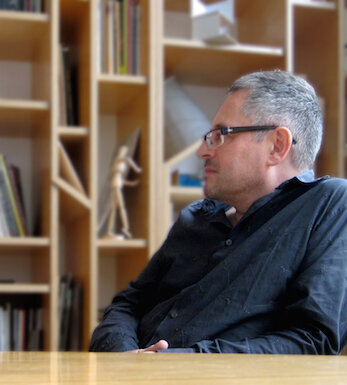INTERVIEW: Roger Mann, Casson Mann
Roger Mann is a co-founder of Casson Mann, a design company specialing in exhibitions, museums and interiors. Our last project with Roger was “Nelson, Navy, Nation”. This permanent exhibition at the National Maritime Museum is now open and admission is free.
What are you working on right now?
We have recently started working on two very exciting and rather different projects: a major gallery on the history of flight for the new Patricia and Phillip Frost Museum of Science in Miami, and a brand new museum for Blackpool to celebrate the unique place it holds in the development of British popular culture. “Feathers to the stars” will show how human ingenuity, curiosity, and the impulse to see further and go farther gave rise to human flight. Telling Blackpool’s story will be an “unconventional” experience: in a refurbished Pavilion Theatre within the Winter Gardens, we are seeking to create a dynamic blend of museum, visitor attraction and theatre, to bring together artifacts, multimedia and performance in a manner that communicates the lively spirit of this special town.
Favourite interior space in London?
I have to say the Central Hall at the Natural History Museum – recently renamed Hintze Hall. I’m a Londoner and since I can remember, along with many thousands of other kids growing up in this city, this was my favourite museum to visit. Waterhouse’s stunning Romanesque architecture animated by all the creatures playfully incorporated into the terracotta is magical, particularly with the sunlight streaming in. For the last year or so, we have been tasked with redeveloping this extraordinary space, to design new displays in all the side bays, the balconies and even look at what might replace the Diplodocus cast in the centre, and it feels like a huge privilege.
You use a clearly defined story as the filter for design decisions. How are you able to get the story so well defined?
We place a great deal of emphasis on research and listening to experts, working with curators, and we have in-house expertise in developing narratives. As part of our process, we are always asking ourselves, ‘What do visitors really want to know? What will excite and inspire them?’.
Do your personal design preferences ever creep into a project, or is it always strictly about the story?
It is very much about the two coming together. The story is always the starting point and the challenge is how to transform that story into an engaging spatial experience for visitors. Knowing that most museum visitors do not want to read large amounts of text, it is important that every aspect of the environment helps to tell the story. To achieve this, the narrative provides the rationale for all the design decisions and material choices we make.
At the same time, as an interior designer, I am passionate about creating meticulously detailed, dramatically lit, beautiful spaces; about orchestrating all aspects of a complex narrative environment – materiality, form, light, colour, sound, media, movement – into one holistic vision; about making environments that stimulate a heightened sense of spatial and sensory awareness in the visitor, a greater openness to engaging with the story.
Each project is bespoke – a tailored response to subject and context, rigorously driven by the story and finely tuned by personal sensibilities.
Cost will always impact the brief, but does cost ever limit design?
We are very inventive, finding cost-effective ways of achieving impactful solutions, but it is important that client ambition and the budget are in the same ballpark from the very early stages of any project.
Any examples of how you have worked around a cost limitation?
Working with good cost consultants from the outset of a project very much allows us to avoid the situation arising.
When you visit an exhibition or a museum, what do you appreciate most?
Fantastic objects, great stories, clever and engaging interpretation, excellent lighting, materiality that is relevant, and spatial design that dynamically underpins the narrative and creates a unique visitor journey – when all this comes together it is usually a very memorable experience.
How should visitor spaces adapt for the Google generation?
Visitor spaces certainly need to attract the Google generation and we can learn a great deal from the way that young people discuss, share and interact with complex media. We really enjoy designing spaces that integrate digital media as the possibilities for bringing subjects to life become so interesting. But we believe that there is often nothing to beat an up-close experience with an original artifact – even for the Google generation.
We don’t read anymore. How has multimedia affected the visitor experience?
We think that multimedia – when it is used carefully and effectively – can really enhance the visitor experience. And did people ever read? It is difficult to think that those long text panels covered with clever words ever really got people excited …
Museums and Galleries have traditionally been places for to inform, to preserve and to share. Is this changing?
No I don’t think it is. Museums and galleries might be changing. But they are becoming better places: better at informing, preserving and, certainly, better at sharing with audiences.



